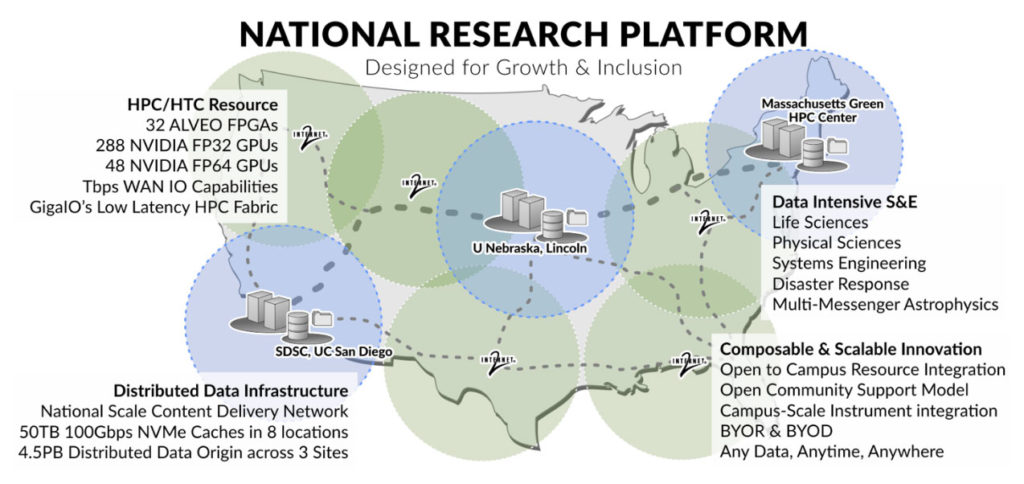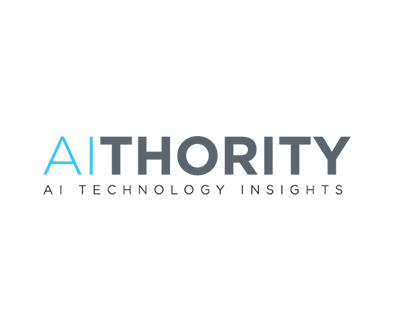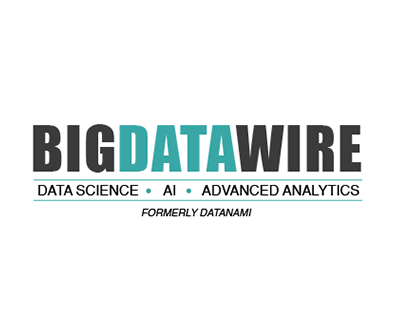Introducing NRP: Accelerating Science with Bold National Research Platform
Note: This article originally appeared on HPC wire, click here to read the original piece.
July 15, 2021 — The San Diego Supercomputer Center (SDSC) located at UC San Diego has heeded the National Science Foundation’s call for a cyberinfrastructure ecosystem that meets the needs of today’s data-intensive science. Proposed as the Prototype National Research Platform (NRP), the innovative, all-in-one system—computing resources, research and education networks, edge computing devices and other instruments—is a testbed for science drivers as diverse as the platform itself to expedite science and enable transformative discoveries.
For this first-of-its-kind resource, the NSF awarded SDSC $5 million over five years, with matched funding for systems operation. The award will support hardware and deployment across three facilities: on the East Coast at the Massachusetts Green High Performance Computing Center (MGHPCC) in Mount Holyoke, Mass.; in the Midwest at the University of Nebraska–Lincoln (UNL) and on the West Coast at SDSC, as well as five data caches in the Internet2 network backbone.
“Supercomputing continues to be instrumental for researchers across an ever-growing number of science domains at institutions throughout the United States,” said UC San Diego Chancellor Pradeep K. Khosla. “SDSC is nationally recognized for innovations in cyberinfrastructure and in building high-performance computational systems specifically designed for scientific research. The NSF sought a national innovator to help improve the crucial resources required to further enhance American prowess in scientific discovery.”
According to Frank Würthwein, interim director of SDSC and principal investigator (PI) on the NRP project, the funding will enable him and the co-PIs from SDSC, UNL and MGHPCC to work with the research community to explore NRP’s experimental architecture.
“NRP provides resources and capabilities for diverse science, plus the expertise of systems people and the user community,” said Würthwein. “It’s an open system designed for growth and inclusion—a way for academic institutions to join a national system and, through their participation, enlarge and enrich the HPC ecosystem.”
Key components of the NRP architecture include research and education networks, compute accelerators, heterogenous computing resources (e.g., edge computing near the instrument location), a content delivery network to provide easy access to any data, anytime, from anywhere, and an overall systems software stack that allows for central management of the system, while remaining open for growth. Innovative technical features of the HPC subsystem include a mix of field programmable gate array (FPGA) chips, graphics processing units (GPUs) with memory and storage in a fully integrated extremely low-latency fabric from GigaIO.
“The selection of our FabreX dynamic fabric for the composable architecture of this new research platform aligns with our mission to deliver the infrastructure agility and performance needed for next-generation science discovery,” said GigaIO CEO Alan Benjamin.
The broader impact of NRP is focused on four themes: 1) empowering underrepresented and/or underresourced researchers by making them “co-owners” of NRP via the “Bring Your Own Resource (BYOR) / Bring Your Own Device (BYOD)” program; 2) societal wellbeing, focusing on health and disaster response; 3) STEM education, workforce development and outreach; and 4) enhancing industrial competitiveness.
“Any campus in the continental United States is reachable from some of the NRP hardware within less than about 500 miles,” said Thomas De Fanti, distinguished professor emeritus of computer science at the University of Illinois at Chicago and research scientist at the Qualcomm Institute at UC San Diego.
UNL will lead NRP’s infrastructure operations using Kubernetes to manage remote systems at the three primary sites and Internet2, as well as the BYOR locations.
“Kubernetes is a new interface and new operations model for many in research computing. We are excited to expand the community’s experience with Kubernetes while providing cyberinfrastructure resources to scientists,” said Derek Weitzel, research assistant professor of computer science at UNL’s Holland Computing Center.
System deployment will take place at SDSC on the UC San Diego campus, where several science drivers from astrophysics, molecular dynamics, health sciences and more will participate. For example, Director of the National Center for Microscopy and Imaging Research (NCMIR) Mark Ellisman will consider how NRP can enhance NCMIR’s work with NSF and other agencies to build multi-scale wiring models of the brain and of the molecular components that make brain cells the most energy-efficient information mediators known.
“Success on this [project] will allow more harmonization with other key NSF initiatives, like NeuroNex2,” noted Ellisman, referencing the technology-enabled, team-based neuroscience project, for which he is a group lead.
NRP will also support research on the science of wildfires. SDSC’s Chief Data Science Officer Ilkay Altintas, for example, works with researchers to build tools and techniques such as WIFIRE for firefighters. NRP will offer urgent computing resources in support of fire-perimeter predictions that can be used on the ground by fire managers to identify where to most effectively deploy firefighting resources to achieve fire containment.
Other examples of NRP’s versatility include leveraging UNL’s expertise in livestock management and using shared instrumentation for precision animal management, and UNL Professor Robert Twomey, a digital artist, researcher and educator at the Johnny Carson Center for Emerging Media Arts, who will explore the poetic intersection of human and machine perception.
The NRP project is structured as two distinct phases: the testbed phase, which includes evaluation and expansion of NRP for science and engineering research (years one to three), and the allocations phase, which involves widespread adoption of the NRP resource (years four to five).
“We aspire for our science drivers to not just use the infrastructure but to intellectually impact each other, forming mutual support networks that we enable via managed Slack channels in addition to more standard user support. We consider this in itself a testbed for scalable user support of an HPC system,” said co-PI Mahidhar Tatineni, SDSC.
The NRP will be deployed in the first half of 2022.



